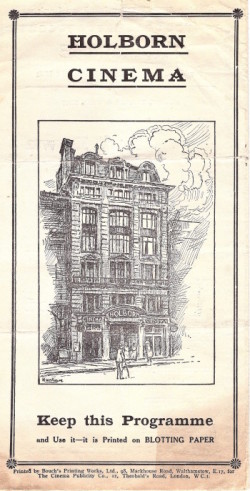The Embassy Theatre at nos 210-211 High Holborn, previously known as the Holborn Cinema, originally opened on 15 October 1910 and seated just under 500 people, with a tea lounge on the ground floor.1 Situated outside the main West End entertainment district, Holborn boasted its own, smaller cluster of venues, which eventually included the Holborn Restaurant, the Holborn Empire music hall, the London Opera House on Kingsway (later the Stoll Picture Theatre) and the Victory Cinema on Theobalds Road (later the Bloomsbury Super Cinema).2 An observer in 1915 said that the Holborn Cinema commanded ‘the regular attention of boarding house residents round the Bloomsbury district’, as well as attracting the ‘casual patronage’ of passersby.3
In September 1923, the cinema was taken over by new management, renamed the Embassy and converted to use as a live theatre.4 However, the new policy didn’t last long, and by the end of the year the venue had become a cinema again. From December 1923 to January 1924, it was advertised as London’s first and only ‘short film theatre’. This was the initiative of New Era Films, the distributors of Secrets of Nature, a series of short natural history films.5 Titles from the Secrets of Nature series formed the bulk of the regular programme. The opening show also included a short ‘quality’ drama, the first part in a new scientific film serial, (The Elements of an Automobile) and an illustrated talk about natural selection.6
After its brief time as London’s ‘short film theatre’ came to an end, the cinema was taken over by George Lattimore. Lattimore was a Black lawyer and businessman from New York, who had come to London in 1919 as the manager of the jazz band the Southern Syncopated Orchestra.7 Around 1923, he made the move into film exhibition, organising special shows at the Philharmonic Hall on Great Portland Street (where the Southern Syncopated Orchestra had previously played), including screenings of Cradle of the World and Sodom and Gomorrah.8 In March 1924, Lattimore stated that his new policy for the Embassy was to show ‘only films of a high class, which the average film exhibitor is disinclined to handle’.9 This policy lasted until June, with the cinema showing long runs of the German film The Street and the French films Kean and Infatuation. The cinema closed for good soon after.
Lattimore’s experiment at the Embassy may have been ahead of its time. However, as the film critic Paul Rotha later observed, it formed an early chapter in the history of ‘unusual’, or specialist, film exhibition in London, which would soon include the activities of the Film Society (from 1925) and other commercial ‘art’ cinemas, such as the Avenue Pavilion and the Palais de Luxe.10 The building at nos 210-211, Holborn was later taken over by a metal casement manufacturers, and is now the site of a bank.11
Image: Programme for the Holborn Cinema, predecessor of the Embassy Theatre, 1920.
Further reading:
- Mark Aston, The Cinemas of Camden (London: London Borough of Camden, 1997).
- Allen Eyles with Keith Skone, London’s West End Cinemas, third edition (Swindon: English Heritage, 2014).
- Paul Rotha, ‘The “Unusual” Film Movement’, Documentary News Letter, June 1940, p. 13.
- Mark Aston, The Cinemas of Camden (London: London Borough of Camden, 1997), p. 19. ↩
- Allen Eyles with Keith Skone, London’s West End Cinemas, third edition (Swindon: English Heritage, 2014), pp. 38-9. ↩
- ‘Our Weekly Visits to London Shows’, Kinematograph and Lantern Weekly, 18 March 1915, p. 55. ↩
- ‘New Embassy Theatre’, The Times, 25 Sept. 1923, p. 7. ↩
- ‘Films of the Week’, The Times, 10 December 1923, p. 12. ↩
- ‘Cinema of Short Films’, Daily Express, 8 December 1923, p. 3. ↩
- Howard Rye, ‘The Southern Syncopated Orchestra’, Black Music Research Journal, 29:2 (2009), 153-228. ↩
- ‘Adventures of a Hunter-Prince’, Daily Express, 4 August 1923, p.7; ‘Trade Notes’, The Bioscope, 6 March 1924: p. 35. ↩
- ‘The Film World’, The Times, 31 March 1924, p. 10. ↩
- Paul Rotha, ‘The “Unusual” Film Movement’, Documentary News Letter, June 1940, p. 13. ↩
- Aston, Cinemas of Camden, p. 19; Eyles with Skone, London’s West End Cinemas, p. 39. ↩



